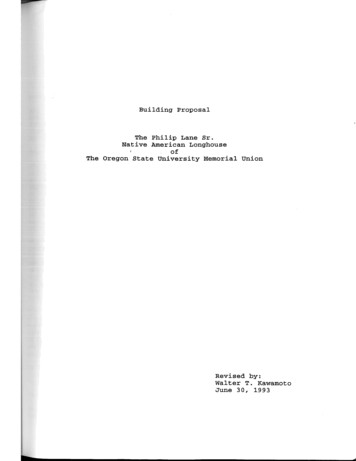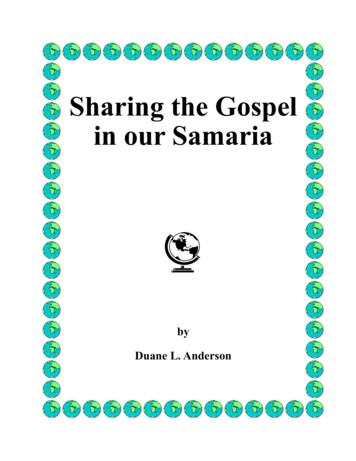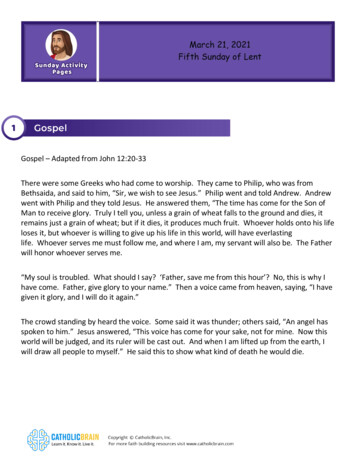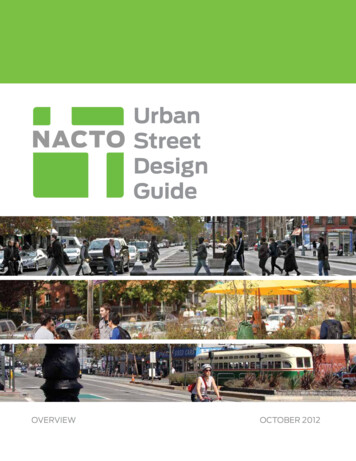
Transcription
Building ProposalThe Philip Lane Sr.Native American LonghouseofThe Oregon State University Memorial UnionRevised by:Walter T. KawamotoJune 30, 1993
ContentsPageLetter of transmittal1Summary2BackgroundThe OSU Memorial UnionThe Native American Longhouse33Why do we need a Longhouse at all?The Big Pictui-eIgnoranceAmerican Indian Student Recruitment668Why do we need a new Longhouse?It's UglyIt's just not enough1112The ProposalThe Philip Lane Sr.Native American LonghouseMajor Components1213MethodSiteSpace and UseGeneral Design ConsiderationsConstituency Funding GroupsFunding Goal1415161718EvaluationUtilization19Future FundingThe Memorial Union19Appendix ALonghouse Advisory Council,Resource Board, andHonorary Resource Board MembersAppendix BLonghouse Staff Structure andJob DescriptionsAppendix CProposed Project BudgetAppendix DUse ChartAppendix EReferences2021222324
Page1Jeremy ScottThe Native AmericanLonghouseSnell Hall, MU EastOregon State UniversityCorvallis, OR 97331November 12, 1993Mr. Charles Rooks, Executive DirectorFred Meyer Charitable TrustSuite 5001515 SW Fifth AvenuePortland, OR 97201Dear Mr. Rooks:Attached you will find a proposal requesting support for a newcultural center titled the Philip Lane Sr. Native American Longhouseat Oregon State University.The existing Longhouse has made greatstrides in recent years towards realizing its two-fold purpose ofproviding social and academic support to American Indian students andbeing a source of information and exchange between the various Nativepeoples and other cultures.With large groups of American Indianstudents about to graduate from high school and outbreaks of racialtension and violence in Oregon and across the nation, there is morework than ever facing our center in the coming years.The Native American Longhouse has proven time and again that itsprograms and personnel are equal to this challenge; it is only in thearea of our facility that we are found wanting.Within just twomedium-size rooms are the administrative center for the Longhousestaff and two student groups, a computer/study area, a kitchen/diningarea, a lounge/meeting room, a storage area, a resource library, andan artifact display area. When one considers the challenges ahead andthe overused state of the Longhouse now, the time is right to beginwork on the new Philip Lane Sr. Native American Longhouse.The Philip Lane Sr. Native American Longhouse is named in honor of thefirst and only American Indian to receive the Oregon State UniversityDistinguished Service award, the university's highest honor. The totalcost of the center to be built on the blessed ground where the oldLonghouse now stands is 2,500,000. Due to current realities in statepublic resources all of the support for this project must come fromprivate sources.We hope that you will join us in strengthening the future of AmericanIndian students and overall race relations.Please direct questionsto me at 737-2738.Sincerely,Jeremy Scott, CoordinatorNative American Longhouse
PageSummarySince1975,the Native American Longhouse,Oregon State University Memorial Union,'purpose:hasasa part offulfilled athetwo-foldsupporting American Indian Students and sharing the richdiversityofNativeOSU/Corvallis community.AmericanculturewiththerestoftheThe old WWII Quonset but which houses themany Longhouse programs, clubs, services, and activities, is no longeradequate for the OSU American Indian community's presentfuture challenges.needs andThe old Longhouse is long overdue to be torn down,and a new Longhouse which symbolizes the best of ancient and moderndesigns must take its place.An estimated 2.5 million dollarsLonghouse.We are far from that goal.is needed to build the newThe OSU Memorial Union and theAmerican Indian community of Oregon State University invite you tohelp make the Philip Lane Sr. Native American Longhouse a reality.
Page3BackgroundThe OSU Memorial Union:Officially opened during the homecoming of1928, the Memorial Union is,"Dedicated to the service and inspirationof the living and to the memory of our immortal dead"pg.The Memorial Union231).is both the(Harris,"living room"1984,oftheuniversity providing opportunities for informal association and a partof the educational program serving as a laboratory for citizenship. Asthe center of campus activity, the Memorial Union touches the lives ofevery student, faculty, administrator, alumnus, and visitor of s13buildings and the combined operating budgets of the Memorial on.ofthosebuildings house the ethnic minority cultural programs, including: theNative American Longhouse, the Lonnie B. Harris Black Cultural Center,theHispanicCulturalCultural Center.Center,andtherecentlydedicatedAsianThese four centers are administered by the DiversityEducation Coordinator and the Memorial Union Board and are advised bycouncils made up of interested faculty and students.Each of them intheir own way serves their constituency and promotes understanding andrespect for the diversity in all people.The native American Long-house:Spring ofNative1975Americantwo-thirds of Moreland Quonset HutLonghouseRecreation Center Boathouse.wereLeft over from World War II,andone-thirdbecamebecame the"F"thein theOSUOutdoorThe blessing and dedication ceremoniesattended by many Indian and Non-Indian supportersincludingAmerican Indian Elder, Educator, and Spiritual Leader, Gilbert WalkingBull.His blessing upon the Longhouse was that at no time would,
,headmonished all in attendance and theirsuccessors to work side by sidein support of Indian students and in celebrationof Indian culture.Starting with what amounted to two barren rooms,American ycreatedathriving center.Todayseveral active organizations of the OSU AmericanIndiancommunity call the Longhouse home, includingthe Native AmericanLonghouse,chapterthe Native American Student AssociationoftheAmericanIndianScienceand(NASA),the OSUEngineeringSociety(AISES), and the Scissortail edin1969.Although its core is composed of American Indianstudents, NASA takespride in being open to everyoneinterested in furthering NativeAmerican culture and education."The purpose is to; preserve NativeAmerican culture, identity, and education;uphold Native supporttheinteraction between community and the culturalethnic groups withinthe community"(Johnson, 1993, pgl.).NASA is the source of mostAmerican Indian cultural events including specialguest speakers fromacross the nation and two yearly Pow-Wows.The 1993 Spring Pow-Wowhad more than a thousand people in attendancefrom OSU, Corvallis, andtribes from across the nation.More recently formed,ScienceandEngineeringthe OSU chapter of the American IndianSociety(AISES),isfocussedonopportunities in the Sciences for American IndianStudents.careerIt is
Pagevery important because,5as a part of a national organization, AISESgives Indian students a sense of being a part of a greater communityof professionally bound peers.The OSU AISES chapter was the recentrecipient of the 1992-1993 Distinguished Chapter Award.The Scissortail Singers is a group of faculty, community members,and students who have formed a southern style American Indian drumgroup.They sing and drum at Pow-Wows across Oregon and the nationand bring distinction to OSU as one of the few universities in thecountry to have a drum group.All of these groups are hosted by andmeet in the Longhouse at least once a week.The Longhouse has alsobeen host to numerous other groups such as the Red Cedar Circle, theConfederated Tribes of Siletz Education Committee, Japanese studentsfrom Asia University, and the OSU Educational Opportunities Program toname a few.The Longhouse mission serves as a good introduction intothegoals and functions of the facility.1"The mission is to be an integral part of the educational processthrough programs and services which address the social, cultural,physical, and intellectual needs of students as OSU.By providing anenvironment which promotes participation and fosters learning, we makeasignificant contribution to the outcomes of the educationalexperience that extends beyond the college years.we also acknowledgeour commitment to welcome the participation of faculty, staff, alumni,and visitors." (Johnson, 1993, pg.l)The Longhouseisgoverned by alltheactive constituentsofthefacility, the General Assembly, and advised by a council (Appendix A)comprised of administration,faculty,staff,community,and studentmembers who represent different interests in the Longhouse includingrepresentatives from the two student groups, NASA and AISES.The day-to-day needs of the facility and its constituents are taken care of bythe Longhouse staff (Appendix B).
Pageroom servesOneMacintosh,ascomputeraand one printer),resourceareaIBM,oneAISES desk area,administrative area,study table, reception area, and craft area.(oneAISES and NASA each havea desk for filing and other administrative uses. The other room servesaskitchen,healing,meeting/lounge area,NASA desk area,sewing area,storage area,altar for spiritualand hasarestroom.TheLonghouse is also host to many guest speakers including tribal leadersfrom around the state and the nation and many workshops includingregalia making workshops.Weekly attendance is estimated to be inexcess of one hundred people.The facility is being used in onefashion or another all hours of the day, sometimes as much as twentyfour hours during finals week, seven days a week.Why do we need a Longhouse at all?The Big Picture:Recent demographic data shows that this country isbecoming more ethnically diverse than ever before.As this happensthere will be a greater need for knowledge about different ethnicgroups and how best to bring them together towards a very differentfuture, without losing the rich heritage of each group's past.Therewill also be a need to recruit and retain greater numbers of ethnicminority students into the universities, as they take their places inthe work force of the future.Ignorance: Racism and the accompanying prejudice, discrimination, andviolence of one kind or another while always immoral and divisive, areeven more of an issue today in theface ofscarce resources andgrowing numbers of ethnic minorities. Although there is no complete!,
Page7agreement on the exact causes of racism, most people agree that partof the equation has to do with ignorance and stereotypes.Stereotypescaused by initial misinformation of, lack of contact with, and littleaccurate knowledge of different kinds of people are widely thought ofas the best first target in the war on racism.Many well intentionpeople with good hearts may believe that they are not racist while racistdiscrimination.Examples abound in the literature which support the idea standing.toSocial psychologists have learned that ignorance is a way that 987;1982).Political scientists have learned that ignorance has been used ons1988).theorists and researchers have found that breaking down stereotypesand ignorance is essential for intercultural communication competence(Klineberg, 1982; Brislin, 1986)The Longhouse and other multicultural programs strive to cietythatcelebrates the cultural diversity in everyone. Multicultural educatorshave been steem ofethnic minorityprovide alternatives to biased resourcematerials (D'Souza, 1991), and address stereotypes in biased curricula(SanJuan,1991),despitemovement which threatensmovement (Berliner,thingssuchas1993).and becauseoftherightistto distort and crippleclassicalthe multiculturalAmerican Indian educators have suggestedteaching about modern day Indianlifeinstead of
Page8assuming that native culture ended at the last Indian massacre sincethe beginnings ofthe multicultural movement(Dodge,1977).Today,American Indians are still at the forefront of diversity chtobothperspectives on the contributions of Christopher Columbus.The Longhouse continues to play its part by offering ,publicationsandseminars to all interested parties in the facility and by going out tothe community and dispelling stereotypes in preschool to college levelclassrooms,the Girl Scouts,the Odd Fellows andthe Boy Scouts,numerous other community groups.American Indian student recruitment and retention: Half or more of thework force in the United States twenty years from now could very wellbe non-Euro-Americans.This strikes fear into the hearts of businessand community leadersalike becausethe ratesofethnic minoritystudents finishing high school and going on to higher education arestill not much better than the dismal numbers of twenty and thirtyyears ago.No where is this crisis felt more acutely than in theAmerican Indian community.Graduation from high school is so raresome timesthatgraduates.The rare occurrence of a person going off to college isalltoitisaoften marred byreturningalltootime of jubilation when a tribal membertheearly.sightMuchofhasthatbeenperson droppingwrittenaboutout,ethnicminorities in education, tracking their progress and projecting theirfuture achievementsdifferencesin(American Council on Ed.,achievement(Jacob&Jordan,1985)1987;and explainingOgbu,1987).
Page9American Indian literature on this area can best be divided into twoareas.The first area is research attempting to find reasons for thedifferences in achievement and retention between different groups ofIndianand/or non-Indian students.studentsThestressofsocialacculturation is a significant factor in under achievement and ons may be positively (Huffman et.(Scott, 1986) related to'achievement.al.,ofnative1986)culturalor negativelyEnvironmental factors explain agreat deal of the variance in GPA of some American Indian students1988). The single factor that was related to the highal.,(Lin et.academic achievement of a sample of 107 Navajo Indians was the family(Rindone,Patton and Edington (1973)1988).found different reasonsfor Indian student persistence at two different New Mexico schools.At New Mexico State the factors were sex, Indian club membership, age,and high school.oftypeacademichighAt the University of New Mexico the factors wereandschoolpreparation,Family talinstitutionalcommitment, and personal motivation are other factors which have beenfound to significantly promote Indian student retentionAitken, 1984)(Falk sisincreased when they receive a quality higher education experience in asupportive atmosphere.One way to accomplish thisisto createtribal colleges or some other type of institutional form of itutionshaveestablished department size programs designed to help all those thathavetraditionally been shut out of higher education including low
Pagedisabled students, and ethnicincome, rural Euro-American students,Oregon State University hasminority students.10the EducationalOpportunities Program, the University of Lethbridge has the UniversityPreparation Program (Beaty,Program whichCounselorisand Alaska has the tudents in institutions like the University of Alaska (Kleinfeld et.al.,1987).Teachingthe Native American Child details howdifferences between whiteculturaland Native Americanthesocietiesaffect the educational progress and development of American IndianSubtle and overt faculty andstudents of all ages Gilliland, 1988).administration support, or the lack thereof, is also a major factor inthe success of Indian students (Hornett,The urgency of the1989)education crisis facing American Indian students is so profound thattribal leaders are utilizing every opportunity to express the need foreducational reform (Red Horse, 1986).The OSU Longhouse does its part to recruit and retain AmericanIndian students.It doesso by supporting the effortsof otheruniversity programs such as the Native Americans in Marine ScienceProgram,the Educational Opportunities Program,the Indian EducationOffice, the Multicultural Affairs Office, the PROMISE program, and theASOSU Ethnic Minorities and Disabled Students Task Force and otherthe Benton Countycommunity programs such as Chemawa Indian School,Inter-Tribal Indian. Council, the Oregon Indian Education Association,the Coalition of Oregon Indian Students,Education e Oregon MulticulturalPeopleThe Longhouse also initiates career,orientedworkshopsandofColorStudentfinancial aid,andprograms.Thementor/tutor
Page11Longhouse provides computer facilities and space for Native Americansto practicetheir spiritual traditions.The facility also providesopportunities for networking with faculty and administration,the two Indian student groups,and serves ashostsan advocate for theinterests of Indian students in cases such as harassment and academicprobation.Perhaps the most important function of the Longhouse is tonurture and support the future leaders of Indian America.Why do we need a new Longhouse?It's ugly:Old Quonset but"F"issuch an eyesore that the OSUPhysical Plant does its best to hide it with huge bushes and greenpaint.Located in the center of campus, people often remark that theyhave been attending OSU for years and never knew where to find theLonghouse. The front entrance facing the Memorial Union turns into asmall lake at the slightest hint of rain."Archives Wall",Inside one room is theso named because posters commemorating events fromthe last twenty years or so are stapled or pinned to the wall.Whatis not obvious is that a few of the posters are covering some rather1large holes in the wall. Monies that might have gone to buying new,quality furniture have goneto more immediate necessities such aselectrical and plumbing repairs.forcedtosettleforsecondThe usersbest.Theofthe Longhouse arefurnishingsandothercharacteristics of the other centers, with their stately old houses,give an American Indian student a glimpse of how highly he or she isregarded by the people of OSU and the state of Oregon.
PageIt's lust not enough:incomingIndian12Aesthetics, safety, and the impression given tostudentsaside,thecurrentprogramsandchallenges of the Longhouse have outgrown its current facility.futureToomuch is asked of the Longhouse on a daily basis with so much happeningin every corner of the two rooms.Often there are people who needplace to meet, vent frustration, relax, say a sacred prayer with sageor sweet grass, and quitely study in the context of their Indian peersall at the same time.facility we now have.Thisissimply not possible in the smallA log of people using the computers is nolonger taken because there are so many people who want to use themthat there is rarely a time when the computer is not being used.Group meetings or guest speaker presentations often so crowed thesmall meeting room/lounge area that people often peek in and don'tbother or flow out into the other room and sidewalk.In the years tocome, more Indian students will need to be served by the Longhouse andthere will be a need to share American Indian culture with even moreof the people who come into contact with OSU and the Memorial Union.That will not be possible given the serious physical limitations ofthe current facility.The ProposalThe Philip Lane Sr. Native American Longhouse:In many ways PhilipLane Sr. is the perfect choice for the namesake of the new Longhouse.His ancestors are Yankton Sioux from the Standing Rock Sioux IndianReservation in South Dakota, but he has spent much of his life in theservice of American Indians in the Pacific Northwest.He embodies theconnections many Indians feel to each other across the nation and the
Pagespecial needs of Oregon and Northwest tribes.13He graduated from OSUin 1941 with a degree in forestry management, reminding us of OregonState University's heritage as a land and sea grant institution.Hisaccomplishments in military service as a part of the Naval Air Corpsand the Corps of Engineers,president Lyndon Johnson,for which he received a citation fromdistinguish him in service to his country.And his work as Spiritual Leader ofthe National American IndianScience and Engineering Society and the organizer and sponsor for theConfederated Indian Tribes at the Washington State Penitentiary puthim at the forefront of American Indian issues (OSU News, 1992).The creation of the new Philip Lane Sr. Native American Longhousewill provide enormous potential for the Memorial Union to enhance thelives of Indian and non-Indian people.The center will be a sitewhere existing strengths in the areas of service to American Indianstudents and outreach to the community can be further developed tomeet present needs and future challenges.The proposed facility willreplace an existing Longhouse that is deteriorating, inadequate,andfunctionallytheobsolete.Thenew Longhousewillhelp propeluniversity into the next century in terms of race relations and thejob training of American Indian professionals.Major Comoonents: The critical needs described above have mandatedthatastate-of-the-artfacility be constructed which will bringtogether all of the necessary program components.The major units ofthe Philip Lane Sr. Native American Longhouse include:a model meeting and seminar center;a state-of-the-art study area, resource library, and computercenter;*a museum quality artifact display and sacred area.*
Page14Method.Site: When Gilbert Walking Bull performed the opening blessing of theLonghouse, he did not just bless the building and its occupants, heblessed the land on which the current Longhouse now stands.Numeroustimes students have risked their health and sacrificed parts of theirin defensesoulofthis pieceofrealestate.The most recentincident of this defense occurred in the Fall of 1992 when a number ofdrunken football fans harassed Longhouse constituents and destroyedLonghouse property.beginning to heal.The woundsfrom thisinvasion arejust nowA new Longhouse can be nowhere else but on thesame land where the current one stands.The only real option is forthe closure symbolized by the tearing down of the old Longhouse andthe rebirth symbolized by the new Longhouse risen from the debris ofthe old facility.Various other site considerations must be taken into account.The Outdoor Recreation Center Boathouse must be relocated.Severalgood spots exist on the periphery of campus with open space for dryingwet rubber boats, seldom used parking spaces for loading, easy accessaway from the heavy traffic in the center of campus, and ample storageareas.A higher degree of use will result in a need for more andbetter bicycle racks and additional parking spaces.Every effort mustbe made to save the venerable old tree outside the current entrance tothe Longhouse.While the new Longhouse is being built,Longhouseprograms and organizations can go on in other Memorial Union generalpurpose rooms.The ability to survive homeless, however, should notbe confused with the ability to thrive and develop and grow withhome.
Pageace and Use:The Philip Lane Sr. Native American Longhouse willhave three levels: a lower level;three timesMore than15a main floor; and a second floor.the size ofthe current Longhouse,the newLonghouse will be a source of growth and development for decades toThe designers of the new Longhouse will use many of thecome.principlesoftraditional cedar longhousesin designing the outerfacade of the facility so that it looks like a real longhouse from theoutside.Inside however,the Longhouse will be a model of moderndesign.The lower level, surrounded by Mother Earth, will be an artifactdisplay and sacred healing area.intoThis area will serve as a windowthe spiritual traditions and beliefs of many American Indiantribes.Here will be displayed the Longhouse ceremonial Drum,NASA Eagle Feather Staff, and other priceless artifacts.theSome specialguest speakers such as elders and other spiritual leaders will speakin the circle of the sacred area.This area's most important purpose,however, will be as a sanctuary for American Indian students to holdon to that part of themselves which truly makes them Indian,theirspirituality.The main floor will serve as the principal meeting, seminar, andadministrative center of the Longhouse.There will be a receptionarea with desk space for Longhouse staff and student group officerscomplete with full office supplies including a phone system,cabinets,and computers.The rest ofthefilingfloor will be a largemeeting room, with the potential to be divided into two smaller rooms,with a fully equipped kitchen at the far end.
Page16The second floor will be the state-of-the-art computer tfourinformation networks and okedIBM andintofivelocalMacintoshandnationallaser printers will be the core of athatisbothstudiousaswellasThe study area will also consist of a quiet study areawith couches, desks, and individual study rooms.There will also beawell supplied Ame'rican Indian and collegiate resource library completewith audio cassettes, video tapes, news from Indian esuchIndianasGREpreparation books, computer manuals, and other publications.General Design Considerations:Manyaspectsoftheinteriorplanning will allow for flexibility of form due to the changing andgrowing needsofappearancedesired throughoutisdifferent Longhouse programs.the building,Whileafinishedimaginative designtechniques such as movable partitions will be incorporated.the nature of the uses of the different levels,trafficwill beonthefirstfloorDue tothe most pedestrianreception and meetingarea.Security for facility staff and users, equipment, and sacred artifactsmust be a primary concern.Although new parking spaces are in order, traffic and parking arenot major concerns.Like the Memorial Union across the way, most ofthe people who use the facility will be walking or bicycling to thefacility from other parking areas or from student ilding.Separate mechanical and air conditioning will need to be provided tothe computer study area for a totally conditioned environment. The
Page17building configuration shall be carefully designed for present andfuture energy conservation.The building should be designed to takeadvantage of passive solar potentials available here in Oregon.TheLonghouse is expected to meet current State of Oregon and federalrequirements for safety accessibility for the disabled.will have a unisex restroom.Each floorThe "One percent for art," principlewill be applied to each level featuring American Indian art from theNorthwest and across the nation created especially for the factor.Apreliminary proposed budget based on the capital improvement programof a recent OSU project of a similar scope,Family Study Center (Glass,The Mercedes A.Batesand an American Indian cultural1988),center with similar functions in Canada (Kirkness, 1993)is includedin Appendix C.Design standards of the State System of Higher Education, OregonState University, the City of Corvallis, and American Indian traditionwill be followed as closely as possible for the Longhouse recognizingthe special nature of the facility as a vanguard in the fields ofethnic minority student services and race relations.Constituency Funding Groups:thePhilip LaneSr.Funds for the design and construction ofNative American Longhouse will be raised byLonghouse and Memorial Union staff members.The funding constituencygroups include: the Oregon State University family (faculty, studentsadministration,andemeritus ther individuals.groupsalumni and ndationstribes,ethnicassociations);and
PageFunding Goal:million.18The funding goal for the new Longhouse project is 2.5This amount includes costs associated with the project:demolition ofthe existing building,equipment, contingencies,fundraising costs.architectfees,inflation factor, permits,construction,surcharges,andThe project budget is located on Appendix C. Nofunding is needed for staffing, maintenance, or programs because thoseexpenses are already taken care of by student funding through theMemorial Union.it'Because of the nature and the goals of the program,is our desire to make the dream of the Philip Lane Sr.NativeAmerican Longhouse a reality by securing 100% of the financingfromthe private sector.The Oregon State University Memorial Union and the AmericanIndian community of OSU respectfully requests your support and invitesyoutojoin with usincreatinganew Longhouse.Appropriaterecognition will be given to all benefactors at their teUniversity'scommitment to ethnic minority students and issues and will createafacility in which many critical needs and future challenges can besystematically addressed.
Page19EvaluationThe primary form of evaluation of the new Longhouse willUtilization:be the degree of utilization along the two purposes of the Longhouse,outreach and American Indian student support.Real and significantgrowth should be marked by a doubling of utilization figures with anaverage ofregularlydouble.double.200 p
Page Summary Since 1975, the Native American Longhouse, as a part of the Oregon State University Memorial Union, has fulfilled a two-fold 'purpose: supporting American Indian Students and sharing the rich diversity of Native American culture with the rest of the OSU/Corvallis community. The old WWII Quonset but which houses the many Longhouse programs, clubs, services, and activities, is no longer











